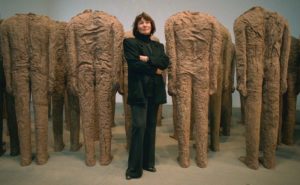
Fot. Wojciech Druszcz/REPORTER
Magdalena Abakanowicz for many years has dealt with the issue of “the countless”. She says: “I feel overwhelmed by quantity where counting no longer makes sense. By unrepeatability within such quantity. A crowd of people or birds, insect or leaves, is a mysterious assemblage of variants of a certain prototype, a riddle of nature abhorrent to exact repetition or inability to produce it, just as a human hand can not repeat its own gesture”.
Each of her figures is an individuality, with its own expression, with specific details of skin. Organic, with the imprint of the artist”s fingers. Their surface is natural like tree bark or animal fur or wrinkled skin. Like all her sculptures also these works are unique objects.
Magdalena Abakanowicz was born in an aristocratic Polish-Russian family on her parent”s estate in Poland. The war broke out when she was nine years old. Then came the revolution imposed by Russia and the forty-five years of Soviet domination.
Poland was a politically volatile country where instability was a permanent state. She has learned to escape to her corner, to make the best of things, to use whatever was viable and even to make gigantic works in a tiny studio. Her art has always addressed the problems of dignity and courage. This dignity resistance and will of survival conceal her individual personal affinities to the culture of Poland, the country where she has grown up, to this country”s political situation, and to the realities of existence of an artist, an intellectual.
The metaphoric language of her work has achieved a point of junction, which still is a challenge for mankind, for all its sophisticated civilisation. This is the point where the organic meets the non – organic, where the still alive meets that which is already dead, where all that exist in oppression meet all that strive for liberation in every meaning of this word. With forty years of work behind her one can see her development like a map unfolded on the table.
On this map the human figure belongs to a vast territory inhabited by crowds and flocks of headless figures. The idea of a crowd has many reverberations in her mind. One of them is the transformation of an individual into a cog. Abakanowicz says: “I immerse in the crowd, like a grain of sand in the friable sands. I am fading among the anonymity of glances, movements, smells, in the common absorption of air, in the common pulsation of juices under the skin…” The entire population of her figures is enough to fill a large public square. They are today over thousand but they have never been seen together. They remain in various museums, public and private collections in different parts of the world. They constitute a warning, a lasting anxiety.
Very few images in contemporary art are as emotive and as disturbing. She started with soft and pliable objects that were rough to the touch. First came the “Abakans” (1966-75), so-called after her own name. These enormous three-dimensional hanging structures, woven form a variety of fibres. Michael Brenson has referred to as not only objects but also spaces. To enter the “Abakans” and to remain inside them is to allow the sensation of interiority to become a condition.
Other soft works included “Embryology” – a sequence of some 800 stuffed potato-shaped forms of varying sizes, covered with sacking and occasionally spilling their innards.
Gradually the objects became hard but continued to be made of fragile or perishable materials. These were the seated or standing figures, backs, hands, heads.
Shy by nature and lonely in the creative process, she has made her contact with people through over one hundred personal exhibitions, which she arranged herself as “still ceremony” hidden behind which she felt secure. She went on to receive large outdoor commissions in Italy, Japan, S.Korea, Israel, Lithuania and other countries she built out of bronze or stone large “spaces to contemplate”, where the tension of space invited the viewer to go between the forms of petrified energy. Each of her forms figurative or non – figurative is rich in its own history. Abakanowicz changed the meaning of sculpture from object to look at into space to experience. The first was “Katarsis”, thirty-three larger than life size, bronze figures, for the Giuliano Gori collection, near Pistoia, Italy.
Subsequently she continues to make works in space. She made bronze figures, human heads, animal and dragon heads, and “Hand-Like Trees” (1994-1997).
This series is still in the process of completion. Apart from bronze, she used tree trunks with steel cuffs for her cycle of “War Games” (1989 – 90).
Abakanowicz, creates ambiguous images with many meanings. Some are concealed, some combined with others. These are what every viewer must find for him or herself. To reveal them all would be to tell the reader how a film ends.

